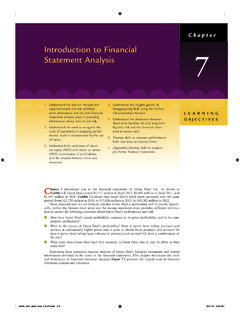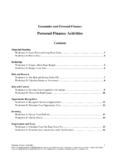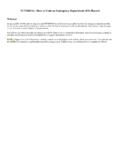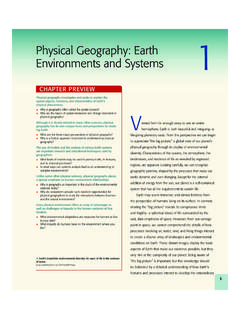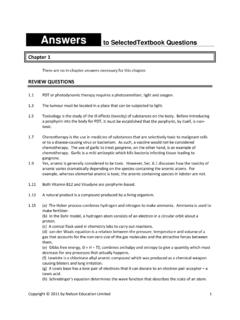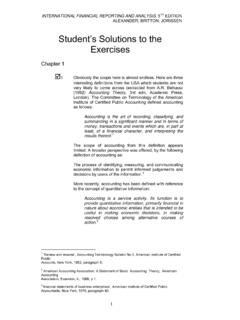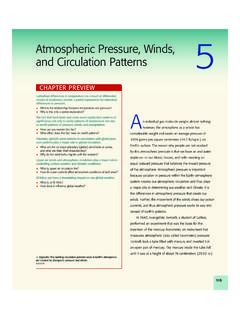Transcription of CHAPTER Managerial Ethics and Corporate Social …
1 CHAPTERM anagerial Ethics andCorporate SocialResponsibilityCHAPTER OUTLINEWhat Is Managerial Ethics ?Criteria for Ethical DecisionMakingUtilitarian ApproachIndividualism ApproachMoral Rights ApproachJustice ApproachFactors Affecting EthicalChoicesThe ManagerThe OrganizationWhat Is Social responsibility ?Organizational StakeholdersThe Ethic of Sustainability andthe Natural EnvironmentEvaluating Corporate SocialPerformanceEconomic ResponsibilitiesLegal ResponsibilitiesEthical ResponsibilitiesDiscretionary ResponsibilitiesManaging Company Ethics andSocial ResponsibilityEthical IndividualsEthical LeadershipOrganizational Structuresand SystemsEthical Challenges in TurbulentTimesEconomic PerformanceSocial EntrepreneurshipLEARNING OBJECTIVESA fter studying this CHAPTER , you should be able to do the following.
2 1 Define Ethics and explain how ethical behavior relates tobehavior governed by law and free the utilitarian, individualism, moral rights, andjustice approaches for evaluating ethical how individual and organizational factorsshape ethical decision Corporate Social responsibility and how toevaluate it along economic, legal, ethical, anddiscretionary four organizational approaches toenvironmental responsibility , and explain the philosophyof how ethical organizations are created throughethical leadership and organizational structures important stakeholders for an organization anddiscuss how managers balance the interests of s Challenge119 timberland is known for great shirtsand solid climbing boots. The com-pany has had a good financial historywith decent revenues and CEO Jeffrey Swartz wantedsomething more.
3 In the early 1990s,he began transforming Timberlandinto a company known as much forphilanthropy as it is for its boots. Itbegan when the community projects-oriented nonprofit City Year askedfor boots for its workers. Swartz con-vinced other timberland executivesto answer the call, over time provid-ing free boots and uniforms for about10,000 people. Visiting some of thecommunity projects, Swartz wasdeeply moved by what volunteerswere accomplishing. I saw what realpower was that day, Swartz recalls. I didn t realize how hungry I was forthat kind of purpose. Timberlandbegan shutting down operations oneday each year so the company s thou-sands of employees could get paid totake part in various company-sponsored philanthropic projects,such as building homeless sheltersor cleaning up playgrounds.
4 Thecompany started giving employees16 hours of paid leave annually tovolunteer at charities of their choos-ing. But the emphasis on socialresponsibility does not come all-day event alone costs about$2 million a year in lost sales, projectexpenses, and wages for timberland s profits weresoaring, that seemed fine, but thenthe company hit a rough patch. Itreported its first operating loss sincegoing public, laid off some employ-ees, and shipped some work over-seas to cut , when one of the company sbankers implied that the focus onphilanthropy was hurting the com-pany and its stakeholders, Swartzfound himself in a quandary. One ofTimberland s bankers bluntly toldSwartz that the company needed to cut this civic stuff out and get backto business.
5 Swartz began wonder-ing if the banker was right. Maybemanagers were failing the organiza-tion and its stakeholders by plow-ing too many resources intophilanthropic you were in this position, would youcut out the charity work and focuseverything on returning Timberlandto profitability? If charity begins athome, is timberland being ethical byspending money for philanthropicactivities at the same time it is ship-ping jobs overseas and laying offworkers? CHAPTER 4 Managerial Ethics and Corporate Social ResponsibilityThe situation at timberland illustrates how difficult ethical issues can be and symbol-izes the growing importance of discussing Ethics and Social responsibility . Managersoften face situations where it is difficult to determine what is right.
6 Thus, Ethics hasalways been a concern for managers. However, in recent years, widespread moral lapsesand Corporate financial scandals have brought the topic to the forefront. Corporationsare rushing to adopt codes of Ethics , strengthen ethical and legal safeguards, anddevelop socially responsible policies. Every decade sees its share of Corporate , political,and Social villains, but the pervasiveness of ethical lapses in the early 2000s wasastounding. It began with Enron Corp., America s seventh-largest corporation in mid-2000. The mighty company was destroyed by a combination of deceit, arrogance,shady financial dealings, and inappropriate accounting practices that inflated earningsand hid debt. Soon, the names of other revered companies became synonymous withgreed, dishonesty, and financial chicanery: Arthur Andersen, Adelphia, WorldCom,Tyco, HealthSouth.
7 A poll taken in fall 2002 found that 79 percent of respondentsbelieved questionable business practices were widespread. Fewer than one third saidthey thought most CEOs were , more than 20 percent of surveyed reported having first-hand knowledge of managers making false ormisleading promises to customers, discriminating in hiring or promotions, and violat-ing employees , the positive news to report is that actor Paul Newman and his friend A. started a company, Newman s Own, that makes salad dressings, spaghettisauce, and other foods and gives all the profits to charity. Boston s Bain & Company setup the nonprofit Bridgespan Group that gives charitable organizations world-class con-sulting advice at steep discounts. And Computer Associates each year pairs75 employee volunteers with 75 employees from major customers to build play-grounds in needy number of companies have begun tying managers pay toethical factors such as how well they treat employees or how effectively they live up tothe stated Corporate CHAPTER expands on the ideas about environment, Corporate culture, and theinternational environment discussed in Chapters 2 and 3.
8 We will focus on the topicof ethical values, which builds on the idea of Corporate culture. Then, we will examinecorporate relationships to the external environment as reflected in Social responsibil-ity. Ethics and Social responsibility are hot topics in Corporate America. This chapterdiscusses fundamental approaches that help managers think through ethical ethical approaches helps managers build a solid foundation on whichto base future decision Is Managerial Ethics ? Ethics is difficult to define in a precise way. In a general sense, ethicsis the code ofmoral principles and values that governs the behaviors of a person or group withrespect to what is right or wrong. Ethics sets standards as to what is good or bad inconduct and decision deals with internal values that are a part of cor-porate culture and shapes decisions concerning Social responsibility with respect to theexternal environment.
9 An ethical issue is present in a situation when the actions of aperson or organization may harm or benefit can be more clearly understood when compared with behaviors governed bylaws and by free choice. Exhibit illustrates that human behavior falls into three cat-egories. The first is codified law, in which values and standards are written into thelegal system and enforceable in the courts. In this area, lawmakers have ruled that peo-ple and corporations must behave in a certain way, such as obtaining licenses for carsor paying Corporate taxes. The courts alleged that Enron Corp. executives broke the120ethicsThe code of moral princi-ples and values that governthe behaviors of a personor group with respect towhat is right or wrong. What Is Managerial Ethics ?121law, for example, by manipulating financial results, such as using off-balance sheetpartnerships to create income and hide debt domain of free choice isat the opposite end of the scale and pertains to behavior about which the law has nosay and for which an individual or organization enjoys complete freedom.
10 A manager schoice of where to eat lunch or a music company s choice of the number of CDs torelease are examples of free these domains lies the area of Ethics . This domain has no specific laws, yetit does have standards of conduct based on shared principles and values about moralconduct that guide an individual or company. Executives at Enron Corp., for example,did not break any specific laws by encouraging employees to buy more shares of stockeven when they believed the company was in financial trouble and the price of theshares was likely to decline. However, this behavior was a clear violation of the execu-tives ethical responsibilities to managers were acting based on theirown interests rather than their duties to employees and other stakeholders.
